Geothermal Heat Pumps
Boost Your Living Space with Improved Indoor Air Quality

Did you know that we spend about 90% of our time indoors? That’s why it’s crucial to prioritize the quality of the air we breathe in our homes. Poor indoor air quality can have a negative impact on our health, causing respiratory symptoms and even more serious conditions like cancer and respiratory diseases. Fortunately, there are steps we can take to improve indoor air quality and create a healthier home environment.
Key Takeaways:
- Indoor air quality is essential for our overall well-being.
- Poor indoor air quality can lead to various health issues.
- Filtering the air, introducing fresh air, and managing humidity are key for improving indoor air quality.
- Removing sources of air pollution and controlling allergens are important steps.
- Using air purifiers and avoiding harmful chemicals further enhance indoor air quality.
Remove Sources of Air Pollution
One of the first steps in improving indoor air quality is to identify and remove sources of air pollution in your home. Many common household items can release harmful pollutants into the air, impacting the quality of the air you breathe.
Cleaning Supplies: Many cleaning products contain chemicals and volatile organic compounds (VOCs) that can contribute to poor indoor air quality. Look for eco-friendly and non-toxic cleaning alternatives, or consider making your own cleaning solutions using natural ingredients.
Paint and Chemicals: Paints, solvents, and other chemicals used for home improvement projects can release harmful fumes and VOCs. If possible, choose low-VOC or VOC-free options, and make sure to properly ventilate the area during and after painting or other projects.
Table: Common Sources of Air Pollution
| Source | Potential Air Pollutants |
|---|---|
| Cleaning Supplies | VOCs, ammonia, bleach |
| Paint and Chemicals | VOCs, formaldehyde |
| Furniture and Upholstery | Flame retardants, formaldehyde |
| Carpets and Flooring | Formaldehyde, VOCs |
| Plastics and Synthetic materials | Phthalates, VOCs |
Furniture and Upholstery: Some furniture and upholstery materials, particularly those treated with flame retardants, can release harmful chemicals into the air. Look for furniture made with natural materials or that are certified as low in volatile organic compounds (VOCs).
Carpets and Flooring: Carpets and certain types of flooring can emit volatile organic compounds (VOCs) and other pollutants. Opt for low-VOC or natural flooring options, and make sure to regularly vacuum or clean carpets to prevent the buildup of dust and allergens.

Improving indoor air quality is a collaborative effort. By removing sources of air pollution, we can create a healthier and safer environment for ourselves and our loved ones. Let’s take the necessary steps to eliminate these sources and breathe easier in our homes.
Next, we will discuss the importance of improving ventilation to enhance indoor air quality.
Improve Ventilation
Good ventilation plays a vital role in enhancing indoor air quality. It helps to circulate fresh air and remove stale air, reducing the concentration of pollutants and maintaining a healthier environment. There are various ways to improve ventilation in your home:
- Open windows and doors: Allowing fresh air to enter your home by opening windows and doors can significantly improve air circulation. This helps to remove indoor pollutants and bring in clean, outdoor air.
- Use exhaust fans: Running exhaust fans in areas with high humidity, such as the bathroom and kitchen, can effectively remove excess moisture and prevent the growth of mold. It also helps to expel odors and pollutants from these spaces.
- Install ventilation systems: Consider installing mechanical ventilation systems, such as whole-house fans or heat recovery ventilators (HRVs), to ensure a continuous supply of fresh air. These systems help to exchange indoor and outdoor air, improving air quality throughout your home.
By improving ventilation, you can create a healthier and more comfortable living environment. Adequate air circulation helps to reduce the concentration of indoor pollutants, control moisture levels, and enhance overall indoor air quality.

Enhancing Indoor Air Quality with Humidity Control
In addition to improving air circulation, controlling indoor humidity is also crucial for maintaining good indoor air quality. High humidity levels can promote the growth of mold and mildew, which can cause respiratory issues and allergies. On the other hand, low humidity can lead to dryness and discomfort.
Using humidifiers and dehumidifiers can help regulate humidity levels in different seasons. In humid climates, dehumidifiers can remove excess moisture from the air, while humidifiers add moisture to dry air in arid regions or during winter months.
Monitoring and maintaining an ideal indoor humidity level between 30-50% can prevent the growth of mold, improve respiratory comfort, and promote better overall indoor air quality.
Use Air Purifiers
Air purifiers are a valuable tool in improving indoor air quality. They are equipped with high-efficiency particulate air (HEPA) filters that can effectively remove airborne particles and pollutants from your home. These filters are designed to capture more than 99% of harmful particles, such as pollen, dust mites, pet dander, and even bacteria and viruses.
By using air purifiers, you can significantly reduce the presence of allergens in your home, which is especially beneficial for those with allergies or asthma. The filtration process helps create a cleaner and healthier environment for you and your family, promoting better respiratory health and overall well-being.
When choosing an air purifier, consider the size of the room and the CADR (clean air delivery rate) of the device. The CADR indicates the volume of clean air produced by the purifier per minute and can help you select the appropriate model for your space. Additionally, some air purifiers offer additional features like activated carbon filters to remove odors and chemical pollutants.
Remember, air purifiers are not a substitute for proper ventilation and regular cleaning practices, but they can be a valuable addition to your efforts in improving indoor air quality.
Table: Comparison of Top Air Purifiers
| Brand | Model | CADR (cfm) | Filtration System | Noise Level (dB) |
|---|---|---|---|---|
| Brand A | Model X | 350 | HEPA + Activated Carbon | 35 |
| Brand B | Model Y | 250 | HEPA | 40 |
| Brand C | Model Z | 400 | HEPA + UV-C | 32 |
Table: Comparison of top air purifiers, showcasing their CADR (clean air delivery rate), filtration systems, and noise levels. Please note that these values are approximate and may vary depending on specific models and configurations.
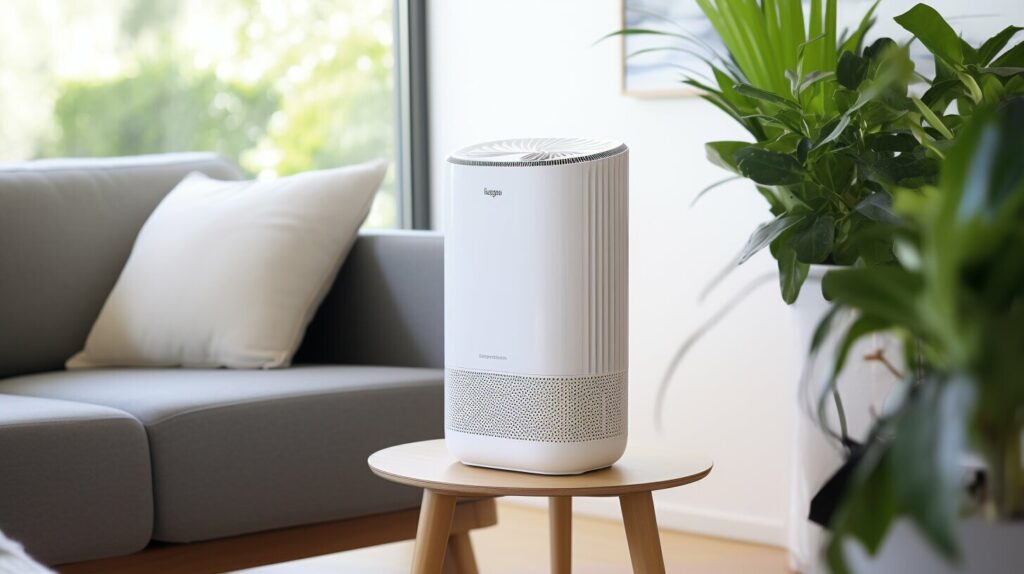
Control Allergens
Allergens such as dust, pet dander, and mold can have a negative impact on indoor air quality. To improve the air you breathe and reduce allergen exposure in your home, here are some effective strategies:
- Clean regularly: Dusting and vacuuming your home on a regular basis can help remove dust and pet dander. Use a vacuum cleaner with a high-efficiency particulate air (HEPA) filter for optimal results.
- Wash bedding: Wash your bedding, including sheets, pillowcases, and blankets, in hot water at least once a week to eliminate dust mites and other allergens.
- Bathe pets: Regularly bathing your pets can help reduce the amount of pet dander in your home. This is particularly important if you or any family members have allergies.
- Use hypoallergenic products: Opt for hypoallergenic pillows and mattresses to minimize allergen exposure while you sleep. These products are designed to repel dust mites and other allergens.
- Control moisture: Keep your home dry and free from excessive moisture to prevent mold growth. Use a dehumidifier in areas prone to dampness, such as basements and bathrooms.
By implementing these measures, you can effectively control allergens in your home and improve the overall air quality. Remember, good indoor air quality is essential for a healthy and comfortable living environment.
Allergen Control: A Case Study
“After implementing these allergen control strategies in our home, we noticed a significant improvement in our indoor air quality. My wife, who suffers from allergies, experienced fewer symptoms and could breathe more easily. Our home feels fresher and cleaner, and we have peace of mind knowing that we are taking proactive steps to reduce allergen exposure. It’s amazing how such simple changes can make a big difference in our overall well-being.”
By following these tips and making a few changes to your daily routine, you can create a healthier and more comfortable living space for you and your family. Taking control of allergen exposure is a crucial step towards improving indoor air quality.

Avoid Harmful Chemicals
When it comes to improving indoor air quality, it is important to be aware of the harmful chemicals that can be found in many household products. Volatile organic compounds (VOCs) are common culprits that can contribute to poor air quality. These chemicals are often found in air fresheners, cleaning products, and other household items.
To create a healthier home environment, it is recommended to avoid using products that contain VOCs whenever possible. Instead, opt for safer, nontoxic alternatives that are labeled as VOC-free. By making this simple switch, you can significantly reduce the amount of harmful chemicals released into the air in your home.
| Common Household Products Containing VOCs |
|---|
| Air fresheners |
| Cleaning sprays |
| Paints and varnishes |
| Adhesives |
| Carpeting and flooring |
In addition to avoiding products with VOCs, it is also important to properly ventilate your home when using any chemical-based products. Open windows and use exhaust fans to help remove any airborne pollutants and maintain good air circulation. This simple step can make a big difference in the overall air quality of your home.
By being mindful of the chemicals you bring into your home and making conscious choices to avoid harmful VOCs, you can create a safer and healthier living environment for you and your family.

Maintain Clean Air Ducts
Air ducts play a crucial role in maintaining good indoor air quality by distributing heated or cooled air throughout your home. However, over time, dust, debris, and other pollutants can accumulate in the ducts, compromising the air flow and potentially releasing harmful particles into the air you breathe. To ensure that your indoor air quality remains high, it is important to regularly clean and maintain your air ducts.
Regular cleaning of air registers and grilles is a simple yet effective way to keep your air ducts in good condition. Dust and dirt can accumulate in these areas, obstructing the airflow and diminishing the overall efficiency of your HVAC system. By removing these obstructions, you can help maintain a healthier indoor environment.
For a more thorough cleaning, it is recommended to hire a professional air duct cleaning service. These experts have the necessary equipment and expertise to safely and effectively remove built-up dust, mold, and other contaminants from your air ducts. They use specialized tools and techniques to reach deep into the ducts and ensure a comprehensive cleaning.
By keeping your air ducts clean, you can prevent the circulation of dust, allergens, and other pollutants in your home, improving the overall indoor air quality and promoting a healthier living environment for you and your family.

Conclusion
Improving indoor air quality is essential for creating a healthier and more comfortable living space. At Our Healthy Home, we understand that the air we breathe has a direct impact on our well-being. By implementing some simple strategies, you can significantly enhance the quality of the air in your home.
First and foremost, it’s crucial to remove sources of air pollution from your living space. By keeping cleaning supplies, chemicals, and other pollutants out of your main living area, you can greatly improve indoor air quality and reduce the risk of respiratory issues.
Another important aspect to consider is ventilation. Proper air circulation is key to maintaining a healthy home environment. Opening windows and doors to let fresh air in, using exhaust fans in bathrooms and kitchens, and managing indoor humidity levels can all contribute to better indoor air quality.
In addition to these measures, utilizing air purifiers with HEPA filters is highly recommended. These devices effectively filter out harmful particles and allergens, keeping the air in your home clean and fresh. Controlling common indoor allergens, like dust, pet dander, and mold, through regular cleaning and preventative measures, also plays a significant role in improving indoor air quality.
Lastly, it’s important to be mindful of the products we use in our homes. Avoiding harmful chemicals found in air fresheners, cleaning products, and other household items can greatly reduce indoor air pollution. Opting for nontoxic alternatives and proper ventilation when using VOC-containing products are simple yet effective ways to create a healthier indoor environment.
By implementing these strategies and maintaining clean air ducts, you can create a healthy home environment with improved indoor air quality. At Our Healthy Home, we believe that everyone deserves to breathe clean, fresh air, and we’re here to guide you on your journey towards achieving a healthier living space.
Can HVAC Systems Help Improve Indoor Air Quality?
Efficient hvac systems play a crucial role in enhancing indoor air quality. These systems filter pollutants, allergens, and pathogens, ensuring cleaner and healthier air. By properly ventilating and controlling humidity levels, efficient HVAC systems help prevent mold growth, reducing respiratory issues. Regular maintenance and filter replacements are essential to maximizing their efficiency and improving indoor air quality.
FAQ
What are some common sources of air pollution in my home?
Common sources of air pollution in your home can include cleaning supplies, paint, and other chemicals. Simply moving these items to a garage or storage area can help improve the air quality in your main living area.
How can I improve ventilation in my home?
Opening windows and doors to let fresh air in can be an effective way to improve air circulation. Running a bathroom or kitchen exhaust fan can also help remove stale, humid air from the home. Maintaining an ideal indoor humidity level of 30-50% is important for preventing the growth of mold and improving air quality.
Are air purifiers effective in improving indoor air quality?
Yes, air purifiers with high-efficiency particulate air (HEPA) filters are effective in removing airborne particles and allergens from the air. HEPA filters can capture more than 99% of harmful particles, such as pollen, dust mites, and pet dander. Using air purifiers can significantly improve indoor air quality and reduce the presence of allergens in your home.
How can I control common indoor allergens?
Regular cleaning, vacuuming, and dusting can help control common indoor allergens like dust, pet dander, and mold. Taking preventative measures like bathing pets regularly, washing bedding in hot water, and using hypoallergenic pillows and mattresses can also reduce allergen exposure and improve air quality.
What should I avoid to improve indoor air quality?
Many household products, such as air fresheners and cleaning sprays, contain harmful volatile organic compounds (VOCs) that can contribute to poor indoor air quality. Avoiding these products whenever possible and choosing safer, nontoxic alternatives can help improve indoor air quality. Thoroughly ventilating your home when using VOC-containing products is also recommended.
How can I maintain clean air ducts in my home?
Regularly cleaning and dusting air registers and grilles, as well as hiring a professional to clean your air ducts, can help improve indoor air quality. Dust and debris can accumulate in air ducts over time, reducing air flow and potentially releasing pollutants into your home.
Why is improving indoor air quality important?
Improving indoor air quality is essential for creating a healthier and more comfortable living space. By removing sources of air pollution, improving ventilation, using air purifiers, controlling allergens, avoiding harmful chemicals, and maintaining clean air ducts, you can significantly enhance the quality of the air you breathe indoors. Prioritizing indoor air quality is a key step towards creating a healthy home environment.
Geothermal Heat Pumps
How to Boost Heat Pump Efficiency With Renewables

Think about a scenario in which our heat pumps operate more efficiently, not harder. With renewable energy readily available, we can maximize the capabilities of these systems.
In this article, we will delve into the realm of heat pump efficiency and explore how renewables can take it to new heights. From solar power to geothermal energy, wind power to biomass, we will uncover the secrets to maximizing performance and achieving sustainable mastery of our heat pumps.
Let’s embark on this journey together.
Key Takeaways
- Solar power and geothermal energy are excellent renewable energy sources for boosting heat pump efficiency.
- Incorporating solar power through the use of solar panels can reduce reliance on traditional electricity sources and lower carbon footprint.
- Geothermal heating systems utilize the constant temperature of the Earth to transfer heat between the ground and the heat pump, resulting in energy savings and reduced environmental impact.
- Wind power and biomass energy can also be integrated with heat pump systems to enhance efficiency and promote sustainability.
Understanding the Role of Renewable Energy in Heat Pump Efficiency
We can enhance the efficiency of heat pumps by utilizing renewable energy sources. Renewable energy integration plays a crucial role in optimizing the performance of heat pumps. When selecting an energy source for heat pumps, it’s important to consider various factors such as availability, cost, and environmental impact.
Solar energy is a popular choice for renewable energy integration due to its abundance and low carbon emissions. By harnessing the power of the sun, heat pumps can operate more efficiently and reduce reliance on conventional energy sources.
Another option is geothermal energy, which utilizes the heat from the Earth’s core to provide heating and cooling. Geothermal systems can significantly improve the efficiency of heat pumps, especially in regions with stable ground temperatures.
Carefully evaluating energy source options is essential for maximizing the efficiency of heat pumps and reducing their carbon footprint.
Evaluating the Benefits of Solar Power for Heat Pump Performance
By evaluating the benefits of solar power, we can determine its impact on heat pump performance. When considering solar power for heat pump performance, there are several key advantages to take into account:
Solar panel installation: Installing solar panels allows you to generate clean and renewable energy directly from the sun. This reduces your reliance on traditional electricity sources and helps lower your carbon footprint.
Photovoltaic technology: Solar panels use photovoltaic technology to convert sunlight into electricity. This means that the energy generated can be used to power your heat pump, reducing the amount of electricity you need to draw from the grid.
Increased efficiency: Pairing solar power with your heat pump can increase its overall efficiency. By utilizing the free and abundant energy from the sun, your heat pump can operate more efficiently, leading to energy savings and lower utility bills.
Incorporating solar power into your heat pump system can have a significant impact on its performance and efficiency. With solar panel installation and the use of photovoltaic technology, you can maximize the benefits of renewable energy for your heat pump.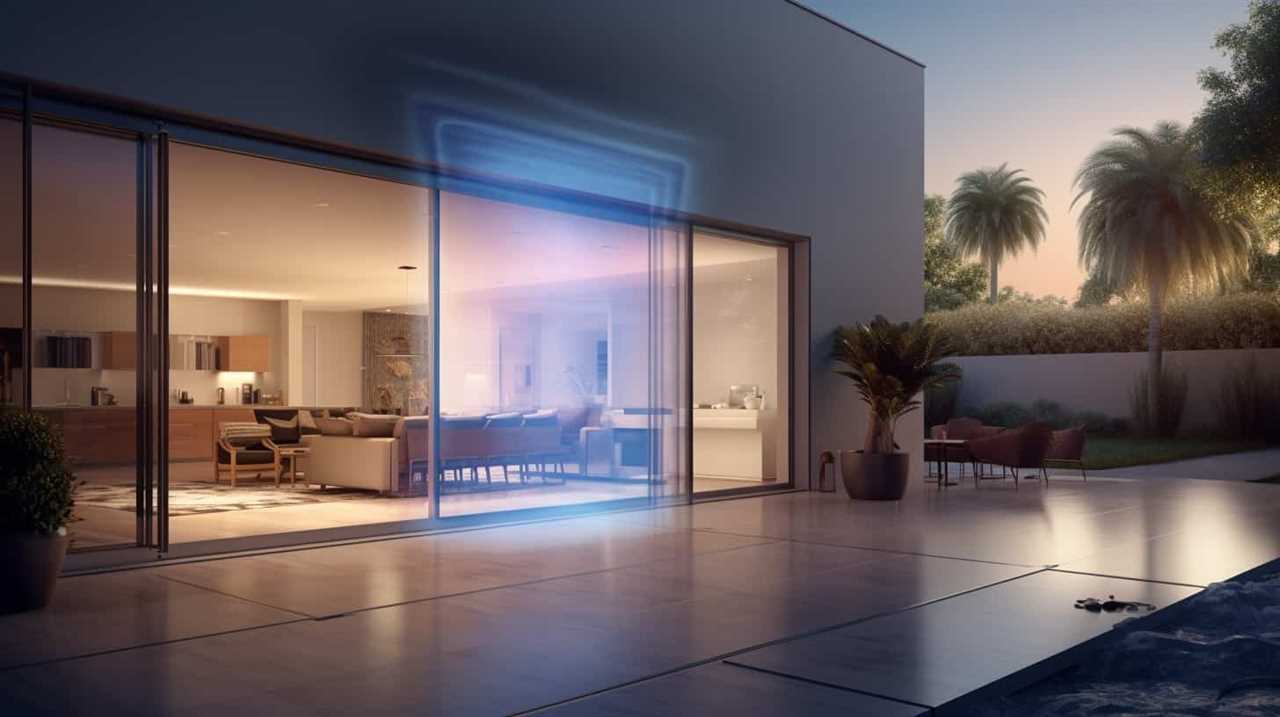
Harnessing Geothermal Energy to Enhance Heat Pump Efficiency
One way to enhance heat pump efficiency is by harnessing geothermal energy. Geothermal heating systems utilize the constant temperature of the earth to provide heating and cooling for residential and commercial buildings. These systems rely on a process called geothermal heat exchange, where heat is transferred between the ground and the heat pump.
The ground acts as a heat source during the winter months, while in the summer it acts as a heat sink. By tapping into this renewable energy source, heat pumps can achieve higher levels of efficiency compared to traditional heating and cooling methods.
Geothermal systems require a well-designed and properly installed ground loop system to effectively transfer heat. It’s essential to consider factors such as soil composition, sizing, and layout to optimize system performance.
With the integration of geothermal energy, heat pumps can operate more efficiently, resulting in significant energy savings and reduced environmental impact.
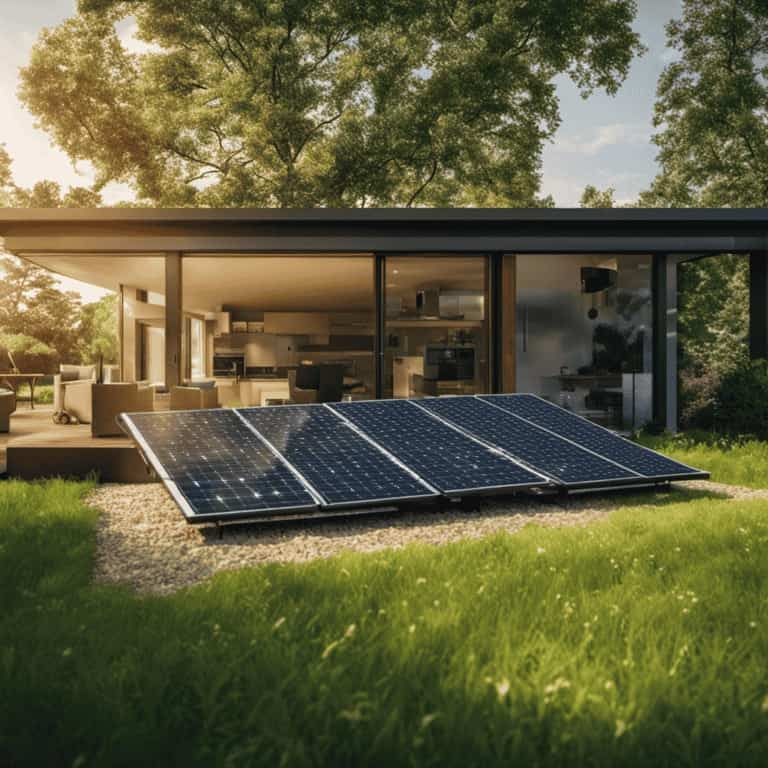
Maximizing Wind Power to Optimize Heat Pump Operation
To optimize heat pump operation, we can maximize wind power through the use of wind turbines. Incorporating wind power integration and wind energy optimization can significantly enhance the efficiency of heat pumps.
Here are three ways to maximize wind power for optimal heat pump operation:
Install on-site wind turbines to generate electricity directly for the heat pump system.
Utilize grid-connected wind power by sourcing electricity from wind farms.
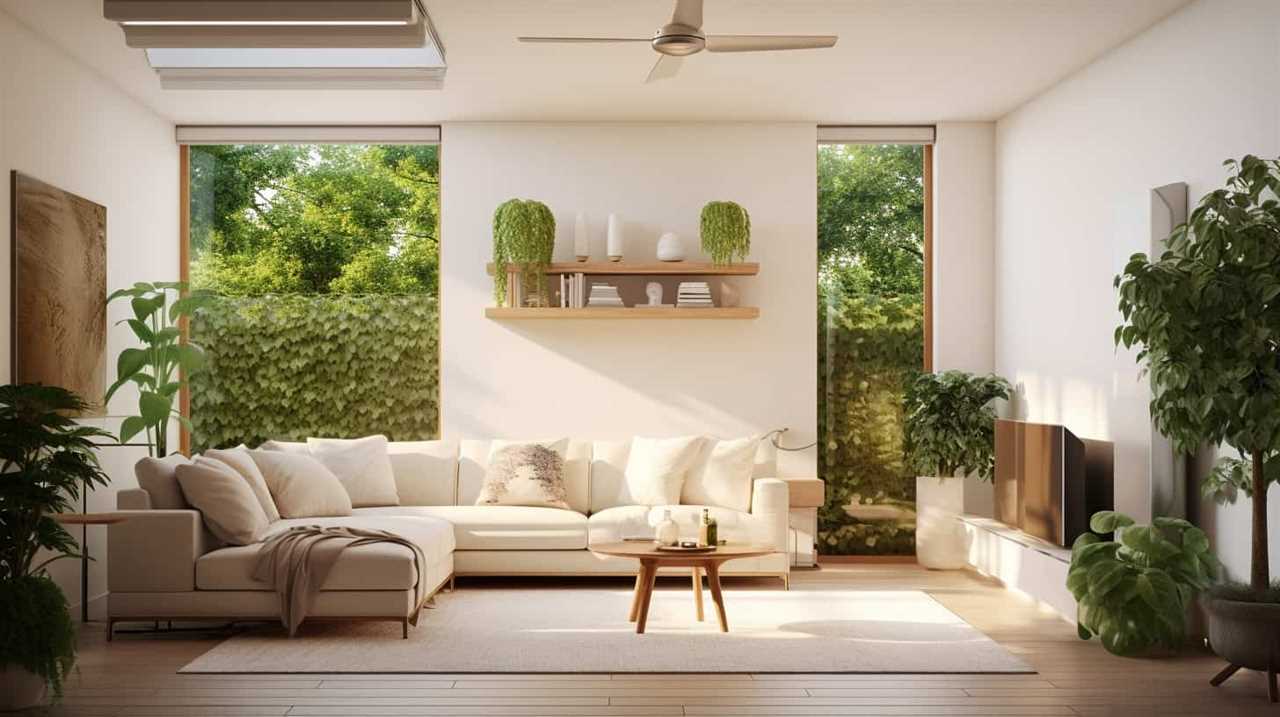
Implement smart controls and energy management systems to synchronize heat pump operation with wind power availability.
By integrating wind power into heat pump systems, we can reduce the reliance on traditional energy sources and decrease carbon emissions. Wind power offers a sustainable and renewable energy solution that aligns with the goal of achieving maximum heat pump efficiency.
Now, let’s explore another renewable energy source, biomass, to further enhance the efficiency of heat pump systems.
Exploring Biomass Energy for Sustainable Heat Pump Efficiency
Our exploration of biomass energy reveals its potential for enhancing the efficiency of heat pump systems.
Biomass sustainability refers to the use of organic materials, such as wood pellets, agricultural waste, or dedicated energy crops, to generate heat. By utilizing biomass as a renewable fuel source, heat pumps can achieve carbon neutral heating, significantly reducing greenhouse gas emissions.
Biomass sustainability ensures that the materials used for fuel are replaced or regenerated at a rate equal to or faster than their consumption. This practice not only minimizes environmental impact but also ensures long-term availability of biomass resources.
Integrating biomass energy with heat pump systems offers a sustainable solution for efficient heating, providing an environmentally friendly alternative to fossil fuel-based heating methods.
Frequently Asked Questions
Can Heat Pumps Only Be Powered by Renewable Energy Sources?
Heat pumps can be powered by a variety of energy sources, including renewable ones. By utilizing renewable energy sources, such as solar or geothermal, heat pump efficiency can be boosted, reducing reliance on non-renewable fuels.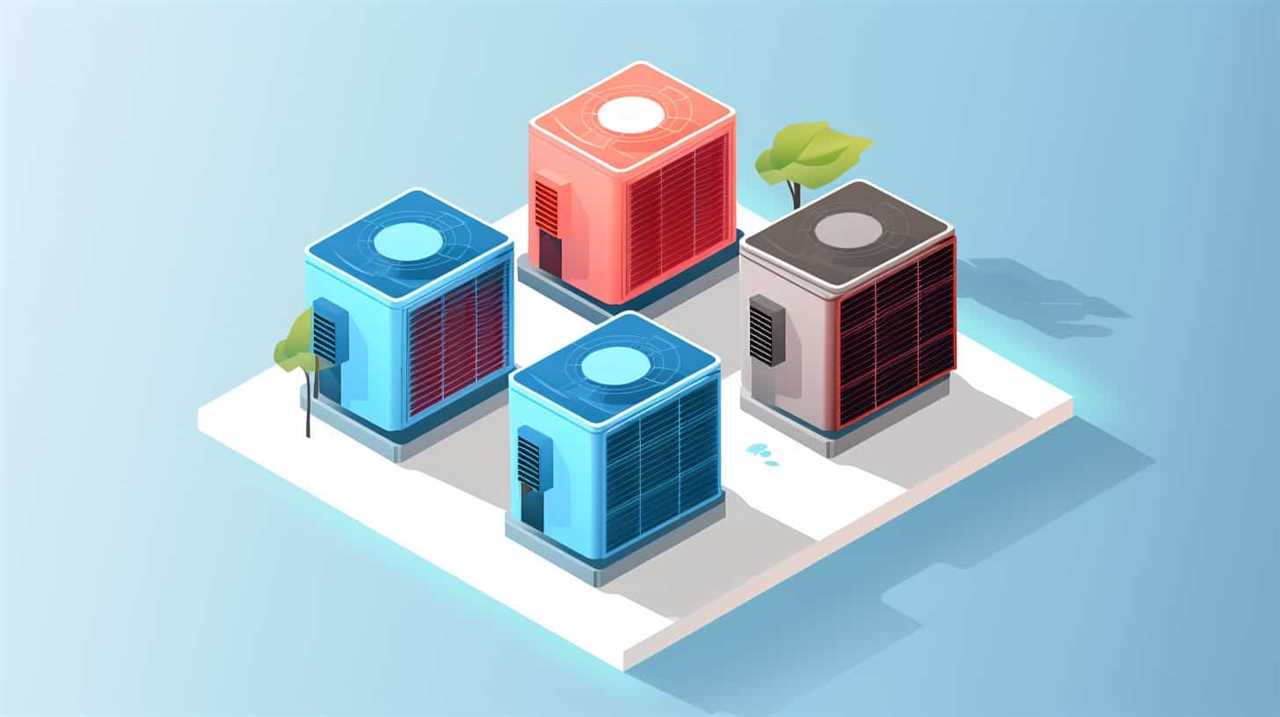
What Are the Main Advantages of Using Solar Power in Conjunction With a Heat Pump?
The advantages of using solar power in conjunction with a heat pump include increased energy efficiency, reduced reliance on fossil fuels, and lower carbon emissions. Solar power can significantly boost heat pump efficiency and contribute to a more sustainable and environmentally friendly heating system.
How Does Geothermal Energy Specifically Improve the Efficiency of Heat Pumps?
Geothermal energy is a game-changer when it comes to boosting heat pump efficiency. It harnesses the Earth’s natural heat, providing a constant and renewable source of energy. This translates to improved performance and lower energy costs.
Is Wind Power a Viable Option for Powering Heat Pumps in All Locations?
Wind power has limitations as an alternative energy source for heat pumps in certain locations. However, there are other renewables, such as solar and geothermal energy, that can be more viable options to boost heat pump efficiency.
What Are the Environmental Benefits of Using Biomass Energy in Heat Pump Systems?
Using biomass energy in heat pump systems provides several environmental benefits. It enhances efficiency by utilizing renewable energy sources. This reduces greenhouse gas emissions and dependence on fossil fuels, contributing to a cleaner and sustainable energy future.

Can Using Renewables Help Pay for an Energy-Efficient Heat Pump?
Using renewables can definitely help pay for energy-efficient heat pumps. By harnessing natural sources like sunlight and wind, renewable energy can power these heat pumps, thus reducing electricity costs. Additionally, governments often offer incentives and tax credits for using renewables, which can further offset the initial investment of installing energy-efficient heat pumps. This makes them a cost-effective and sustainable option for heating and cooling.
Conclusion
In conclusion, by harnessing the power of renewables such as solar, geothermal, wind, and biomass energy, we can unlock the full potential of heat pump efficiency.
Like a symphony of nature’s elements, these renewable sources harmonize with our heat pumps, maximizing their performance and sustainability.
With each renewable energy source playing its unique role, we can create a rhythm of efficiency that flows seamlessly, providing us with a practical and environmentally friendly solution for heating and cooling our spaces.
Geothermal Heat Pumps
Transforming Homes With High-Efficiency HVAC and Heat Pump Systems

Picture a world where our houses are more than just places to stay, but rather sanctuaries of comfort and efficiency. By using high-efficiency HVAC and heat pump systems, we can turn our homes into energy-saving machines, giving us the best heating and cooling possible.
In this article, we will explore the benefits of these innovative systems, understand the technology behind heat pumps, and discover how upgrading our HVAC systems can bring us improved comfort and liberation from high energy bills.
Key Takeaways
- High-efficiency HVAC and heat pump systems save money through energy efficiency.
- These systems improve indoor air quality by removing dust and allergens.
- They reduce carbon footprint by producing fewer greenhouse gas emissions.
- High-efficiency HVAC and heat pump systems provide optimal heating and cooling for homes, enhancing comfort and well-being in indoor environments.
The Benefits of High-Efficiency HVAC Systems
We love high-efficiency HVAC systems because they save us money and keep us comfortable. These systems bring a multitude of benefits to our homes, including improved indoor air quality and a reduced carbon footprint.
High-efficiency HVAC systems utilize advanced filtration technology to remove dust, allergens, and pollutants from the air, resulting in cleaner and healthier indoor environments. Additionally, these systems are designed to operate with maximum energy efficiency, consuming less energy and producing fewer greenhouse gas emissions.
Understanding Heat Pump Technology for Home Heating and Cooling
To fully grasp the benefits of heat pump technology for home heating and cooling, it’s important to understand how these systems work and the advantages they offer. Heat pumps are highly efficient devices that transfer heat from one place to another, providing both heating and cooling for homes. Unlike traditional heating and cooling systems, which generate heat or cool air, heat pumps simply move heat from one location to another.
Heat pump efficiency is measured by the Coefficient of Performance (COP), which indicates the amount of heat produced for every unit of electricity consumed. Generally, high-efficiency heat pumps have a COP of 3 or higher, meaning they produce three units of heat for every unit of electricity consumed. This makes them significantly more energy-efficient than conventional heating systems.
Heat pump installation involves placing an outdoor unit, known as the condenser, and an indoor unit, called the evaporator, connected by refrigerant lines. The outdoor unit extracts heat from the air or ground and transfers it to the indoor unit, which then distributes it throughout the house.
Understanding the inner workings and benefits of heat pump technology sets the stage for discussing the energy savings that can be achieved with high-efficiency HVAC and heat pump systems.
Energy Savings With High-Efficiency HVAC and Heat Pump Systems
With high-efficiency HVAC and heat pump systems, significant energy savings can be achieved through improved efficiency and reduced electricity consumption. This not only leads to cost savings, but also has a positive environmental impact.
Here are two key ways in which these systems contribute to energy savings:
Enhanced Efficiency: High-efficiency HVAC and heat pump systems utilize advanced technologies, such as variable speed motors and smart thermostats, to optimize energy usage. These systems can adjust their output based on the actual heating or cooling needs of the home, resulting in reduced energy waste.
Reduced Electricity Consumption: High-efficiency HVAC and heat pump systems require less electricity to operate compared to traditional systems. This is due to their ability to transfer heat rather than generate it, resulting in lower energy consumption and decreased reliance on fossil fuels.

Upgrading Your Home’s HVAC System for Improved Comfort and Efficiency
Upgrading your home’s HVAC system can provide improved comfort and efficiency by incorporating modern technologies and energy-saving features. By investing in a high-efficiency HVAC system, you can significantly increase energy efficiency and reduce your carbon footprint.
These systems are designed to consume less energy while providing the same level of comfort in your home. They utilize advanced technologies such as variable-speed motors, smart thermostats, and zoning systems to optimize energy usage. Additionally, high-efficiency HVAC systems are equipped with features like programmable timers and sensors that allow you to control and customize your home’s temperature according to your needs. This not only enhances your comfort but also helps to reduce unnecessary energy consumption.
Upgrading your HVAC system is a smart move that not only improves your home’s comfort but also contributes to a greener and more sustainable future.
Choosing the Right High-Efficiency HVAC and Heat Pump System for Your Home
We can select the right high-efficiency HVAC and heat pump system for our home by considering our specific needs and evaluating the available options. Here are some important factors to consider:

Selecting the appropriate size for your HVAC and heat pump system:
Assess the size of your home and the heating and cooling load requirements.
Consult with HVAC professionals to determine the right size based on square footage, insulation, and climate conditions.
Understanding the maintenance requirements of high efficiency systems:

Regularly clean and replace air filters to ensure optimal performance and indoor air quality.
Schedule annual maintenance inspections by licensed professionals to detect any issues and keep the system running efficiently.
Frequently Asked Questions
How Often Should High-Efficiency HVAC Systems Be Serviced or Maintained?
We should regularly service and maintain our high-efficiency HVAC systems to ensure optimal performance and longevity. By conducting frequent maintenance, we can enjoy the benefits of improved energy efficiency, lower utility bills, and a comfortable living environment.
Are There Any Government Incentives or Rebates Available for Installing High-Efficiency HVAC and Heat Pump Systems?
Yes, there are government incentives and rebates available for installing high-efficiency HVAC and heat pump systems. These incentives aim to promote energy savings and make these systems more accessible to homeowners.
Can High-Efficiency HVAC Systems Be Integrated With Smart Home Technology?
Yes, high-efficiency HVAC systems can be seamlessly integrated with smart home technology. However, there may be some integration challenges and it’s important to assess the cost effectiveness of such a system before making the investment.
What Is the Average Lifespan of a High-Efficiency HVAC System?
The average lifespan of a high-efficiency HVAC system depends on regular maintenance frequency. With proper care, these systems can last for 15-20 years, providing efficient heating and cooling for our homes.
Are There Any Specific Requirements or Considerations for Installing High-Efficiency HVAC and Heat Pump Systems in Older Homes?
When installing high-efficiency HVAC and heat pump systems in older homes, there are specific challenges and cost considerations. It’s important to assess the existing infrastructure, insulation, and electrical capacity to ensure compatibility and optimal performance.
What Are the Benefits of Using High-Efficiency Heat Pumps for HVAC Systems?
High-efficiency heat pumps offer multiple benefits for HVAC systems, including green heating with heat pumps. By utilizing energy transfer principles, these systems can extract heat from the outside air and transfer it indoors, providing efficient heating in colder months. This reduces the reliance on traditional fossil fuel-based heating methods, helping to lower carbon emissions and provide cost savings. Additionally, high-efficiency heat pumps can also provide cooling during warmer seasons, offering year-round comfort and efficiency.
Conclusion
In conclusion, upgrading to high-efficiency HVAC and heat pump systems not only improves the comfort and efficiency of our homes but also leads to significant energy savings.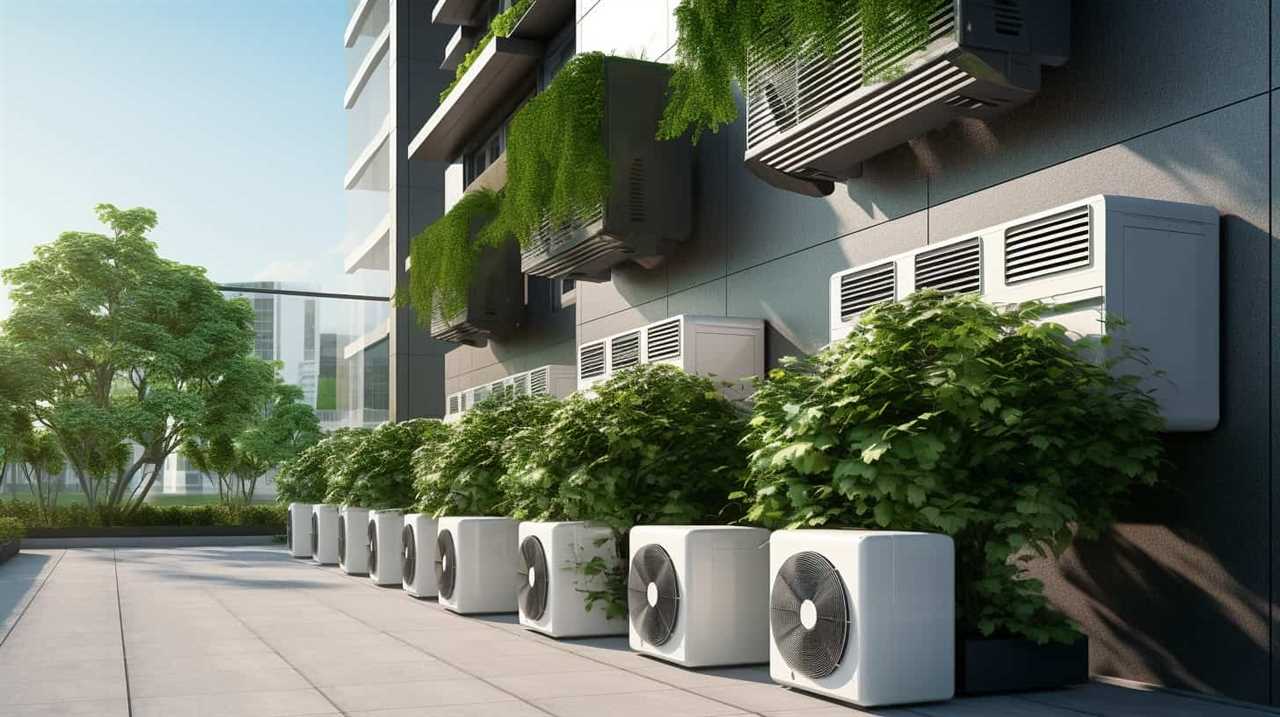
In fact, studies have shown that these systems can reduce energy consumption by up to 50%.
This means that not only will we enjoy a more comfortable living space, but we’ll also contribute to a more sustainable future by reducing our carbon footprint.
Geothermal Heat Pumps
Comparing Heat Pump Efficiency in Sustainable Buildings

In this article, we will explore sustainable buildings and analyze the effectiveness of heat pumps.
We will explore the factors that affect heat pump efficiency, the different types of heat pump systems available for green buildings, and the energy efficiency ratings for these systems in sustainable construction.
By analyzing the performance of heat pumps in green buildings, we aim to provide you with the best practices for optimizing heat pump efficiency in sustainable construction.
Get ready to master the art of comparing heat pump efficiency in sustainable buildings!
Key Takeaways
- Availability of incentives for heat pumps can play a significant role in promoting their usage in sustainable buildings.
- The impact of climate on heat pump efficiency highlights the need for careful consideration of local climate conditions when choosing a heat pump system.
- The importance of insulation in maximizing heat pump efficiency emphasizes the need for proper insulation in sustainable buildings.
- Regular maintenance is crucial for sustaining heat pump efficiency and ensuring optimal performance over time.
Factors Affecting Heat Pump Efficiency in Sustainable Buildings
In our research, we’ve identified several key factors that affect the efficiency of heat pumps in sustainable buildings.
One of these factors is the availability of incentives for heat pumps. Governments and organizations around the world are recognizing the importance of transitioning to more sustainable energy sources, and as a result, they’re offering various incentives to promote the adoption of heat pumps. These incentives can include tax credits, grants, and rebates, which can significantly reduce the upfront costs of installing a heat pump system.
Another factor that affects heat pump efficiency is the climate in which they’re installed. Heat pumps work by extracting heat from the air or ground, and the efficiency of this process is influenced by the temperature and humidity levels. In colder climates, where temperatures drop below freezing, heat pump efficiency may decrease, requiring additional energy to maintain desired indoor temperatures. Therefore, it’s crucial to consider the impact of climate on heat pump efficiency when designing and operating sustainable buildings.
Types of Heat Pump Systems for Green Buildings
When considering heat pump systems for green buildings, we must evaluate the different types available to determine the most suitable option. Two common types of heat pump systems for green buildings are geothermal heat pumps and air source heat pumps.
Geothermal heat pumps use the stable temperature of the ground or water as a heat source or sink. They achieve high efficiency by utilizing the relatively constant temperatures available underground. Geothermal heat pumps can provide both heating and cooling, making them versatile for various climates.
On the other hand, air source heat pumps extract heat from the outdoor air and transfer it indoors. They’re easier to install and require less space compared to geothermal heat pumps. However, their efficiency may vary depending on the outdoor temperature.
Both geothermal and air source heat pumps offer energy-efficient solutions for green buildings. The choice between the two depends on factors such as available space, local climate, and budget considerations.
Energy Efficiency Ratings for Heat Pumps in Sustainable Construction
For our evaluation of heat pump efficiency in sustainable construction, we’ll analyze the energy efficiency ratings of different heat pump systems. Energy efficiency ratings provide essential information about the performance of heat pumps and their ability to save energy. These ratings are determined by industry standards and are based on the ratio of heat output to electricity input.

The higher the rating, the more efficient the heat pump is in converting energy into heat. Energy-saving technologies incorporated into heat pumps, such as variable-speed compressors and smart controls, can further enhance their efficiency.
Comparing the Performance of Heat Pumps in Green Buildings
We will assess and compare the performance of heat pumps in green buildings to determine their effectiveness in providing efficient heating and cooling solutions. A comparison of heat pump performance in green buildings can help us understand the benefits of using these systems in sustainable construction. To facilitate this comparison, we have created a table that highlights the key performance metrics of different heat pump models in green buildings. This data-driven approach allows us to analyze the efficiency, energy consumption, and environmental impact of each heat pump. By examining these factors, we can identify the most effective heat pump solutions for sustainable construction projects. Transitioning into the next section, we will now explore best practices for optimizing heat pump efficiency in sustainable construction.
| Heat Pump Model | Efficiency (COP) | Energy Consumption (kW) | Environmental Impact (CO2 emissions) |
|---|---|---|---|
| Model A | 4.5 | 8.2 | 2.5 tons |
| Model B | 3.8 | 9.6 | 3.1 tons |
| Model C | 5.2 | 7.5 | 2.2 tons |
| Model D | 4.2 | 8.8 | 2.8 tons |
| Model E | 4.8 | 7.9 | 2.4 tons |
Best Practices for Optimizing Heat Pump Efficiency in Sustainable Construction
To maximize heat pump efficiency in sustainable construction, we recommend implementing proper insulation and regular maintenance. These best practices can significantly improve the performance and energy efficiency of heat pumps, leading to reduced energy consumption and lower greenhouse gas emissions.
Here are three key strategies for optimizing heat pump efficiency:
-
Optimizing insulation: Ensuring that the building envelope is well-insulated helps minimize heat loss and maintain a consistent indoor temperature. This reduces the workload on the heat pump, allowing it to operate more efficiently.
-
Renewable energy integration: Pairing heat pumps with renewable energy sources, such as solar panels or geothermal systems, can further enhance their efficiency. By utilizing clean and sustainable energy, heat pumps can operate at higher COP (Coefficient of Performance) values, resulting in greater energy savings.
-
Regular maintenance: Conducting routine maintenance, including filter cleaning, refrigerant checks, and system inspections, is crucial for maintaining optimal heat pump performance. Regular maintenance helps identify and address any issues promptly, preventing energy inefficiencies and potential breakdowns.
Frequently Asked Questions
How Are Heat Pumps Different From Traditional Heating and Cooling Systems?
Heat pumps differ from traditional heating and cooling systems by utilizing the heat transfer process to efficiently heat or cool a space. This results in lower energy consumption and higher efficiency compared to conventional systems.
What Are the Environmental Benefits of Using Heat Pumps in Sustainable Buildings?
Using heat pumps in sustainable buildings offers numerous advantages. They have a positive impact on the environment by reducing greenhouse gas emissions, improving energy efficiency, and promoting renewable energy sources.
Are There Any Financial Incentives Available for Installing Heat Pumps in Green Buildings?
Financial incentives are available for installing heat pumps in green buildings, which can help offset the installation costs. These incentives can include tax credits, rebates, and grants, making heat pump adoption a more financially viable option for sustainable building projects.
Can Heat Pumps Be Used in All Types of Sustainable Buildings, Regardless of Size or Design?
Heat pump compatibility varies in different sustainable buildings, regardless of size or design. However, implementing heat pumps can lead to significant energy savings, making them a viable option for many green buildings.
What Maintenance and Care Is Required for Heat Pumps to Ensure Optimal Efficiency in Sustainable Construction?
To ensure optimal efficiency in sustainable construction, heat pump maintenance is crucial. Regularly cleaning or replacing air filters, checking refrigerant levels, and inspecting coils are essential tasks. Neglecting maintenance can lead to decreased energy efficiency and higher operating costs.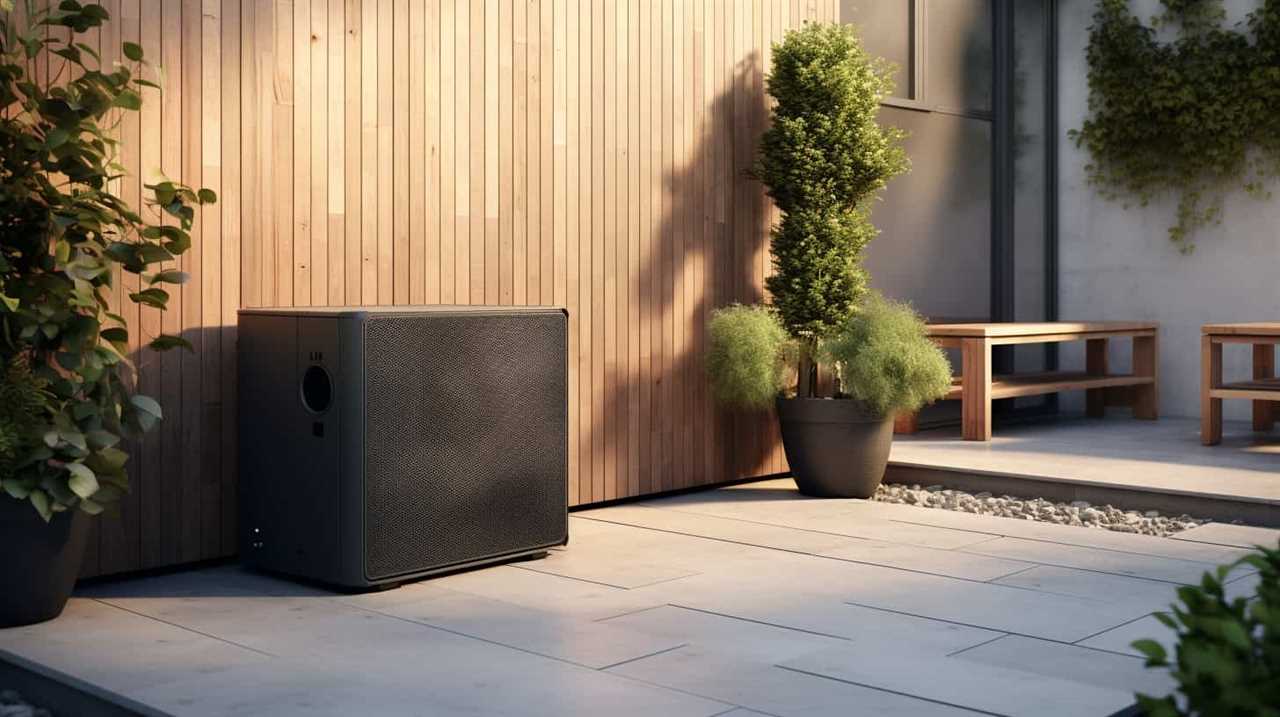
Conclusion
In conclusion, when it comes to heat pump efficiency in sustainable buildings, careful consideration of factors such as insulation, system type, and energy ratings is crucial. By optimizing these aspects, we can achieve significant energy savings and reduce carbon emissions.
For example, a study conducted in a green building with an efficient heat pump system showed a 30% reduction in energy consumption compared to traditional heating methods.
Just like a well-conducted symphony, the harmonious combination of these factors can create a sustainable rhythm for our planet’s future.
-

 Residential and Commercial Applications2 weeks ago
Residential and Commercial Applications2 weeks agoBest Amana Heat Pump Reviews
-

 Thermal Energy Transfer2 weeks ago
Thermal Energy Transfer2 weeks agoBreakthroughs in Modern Heat Pump Systems: Thermal Energy Edition
-

 Residential and Commercial Applications2 weeks ago
Residential and Commercial Applications2 weeks agoBest Heat Pump
-
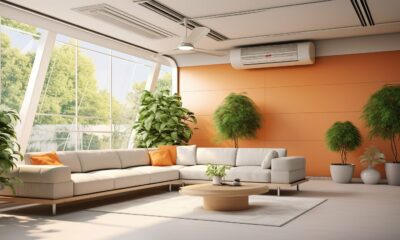
 Geothermal Heat Pumps3 months ago
Geothermal Heat Pumps3 months agoUpgrade Your Comfort with Our Efficient HVAC Systems
-

 Air Conditioning3 months ago
Air Conditioning3 months agoExploring Energy-Efficient Air Conditioning Heat Pumps
-

 Geothermal Heat Pumps3 months ago
Geothermal Heat Pumps3 months agoInnovative Geothermal Heat Pump Manufacturers Revolutionize Energy Efficiency
-

 Thermal Energy Transfer1 month ago
Thermal Energy Transfer1 month agoBoost Your Heat Pump Efficiency: Interactive Guide
-

 Residential and Commercial Applications2 weeks ago
Residential and Commercial Applications2 weeks agoBest Portable Heat Pump Heat & AC










